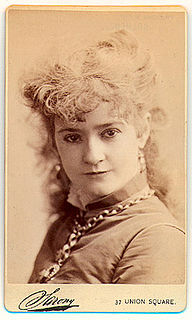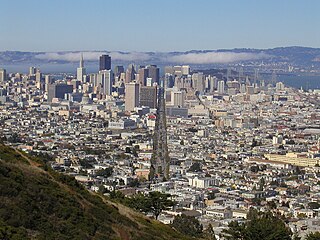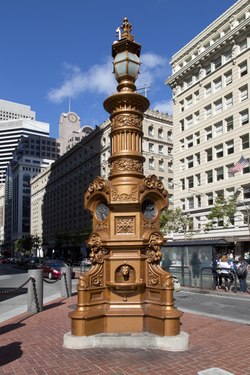
Mission San Francisco de Asís, commonly known as Mission Dolores, is a Spanish Californian mission and the oldest surviving structure in San Francisco, located in the Mission District. It was founded on October 9, 1776, by Padre Francisco Palóu and co-founder Fray Pedro Benito Cambón, who had been charged with bringing Spanish settlers to Alta California and with evangelizing the local indigenous Californians, the Ohlone. Next to the old mission is the newer and larger Mission Dolores Basilica, built in 1918 in an elaborate California Churrigueresque style.

Luisa Tetrazzini was an Italian coloratura soprano of great international fame. Tetrazzini “had a scintillating voice with a brilliant timbre and a range and agility well beyond the norm...” She enjoyed a highly successful operatic and concert career in Europe and America from the 1890s through to the 1920s. Her voice lives on in recordings made from 1904–1920. She wrote a memoir, My Life of Song, in 1921 and a treatise, How to Sing, in 1923. After retirement, she taught voice in her homes in Milan and Rome until her death.

Charlotte Mignon "Lotta" Crabtree, also known mononymously as Lotta, was an American actress, entertainer, comedian, and philanthropist.

Montgomery Street is a north-south thoroughfare in San Francisco, California, in the United States.

The San Francisco Mint is a branch of the United States Mint. Opened in 1854 to serve the gold mines of the California Gold Rush, in twenty years its operations exceeded the capacity of the first building. It moved into a new one in 1874, now known as the Old San Francisco Mint. In 1937 Mint operations moved into a third building, the current one, completed that year.

Kearny Street in San Francisco, California runs north from Market Street to The Embarcadero. Toward its south end, it separates the Financial District from the Union Square and Chinatown districts. Further north, it passes over Telegraph Hill, interrupted by a gap near Coit Tower.

Portsmouth Square, formerly known as Portsmouth Plaza, and originally known as Plaza de Yerba Buena, or simply La Plaza, is a one-block plaza in Chinatown, San Francisco, California. Established in the early 19th century, during the period of Mexican California, the plaza was renamed following the U.S. Conquest of California in honor of the USS Portsmouth, the American ship which captured the city. It is bounded by Kearny Street on the east, Washington Street on the north, Clay Street on the south, and Walter Lum Place on the west.

The Palace Hotel is a landmark historic hotel in San Francisco, California, located at the southwest corner of Market and New Montgomery streets. The hotel is also referred to as the "new" Palace Hotel to distinguish it from the original 1875 Palace Hotel, which had been demolished after being gutted by the fire caused by the 1906 San Francisco earthquake.

Market Street is a major thoroughfare in San Francisco, California. It begins at The Embarcadero in front of the Ferry Building at the northeastern edge of the city and runs southwest through downtown, passing the Civic Center and the Castro District, to the intersection with Portola Drive in the Twin Peaks neighborhood. Beyond this point, the roadway continues into the southwestern quadrant of San Francisco. Portola Drive extends south to the intersection of St. Francis Boulevard and Sloat Boulevard, where it continues as Junipero Serra Boulevard.

Central Tower is a 91 m (299 ft) 21-story office building at Market and Third Streets in San Francisco, California. The building has undergone numerous renovations since its completion in 1898 as the Call Building. It was later known as the Spreckels Building.

The 1906 San Francisco earthquake struck the coast of Northern California at 5:12 a.m. on Wednesday, April 18, with an estimated moment magnitude of 7.9 and a maximum Mercalli intensity of XI (Extreme). High-intensity shaking was felt from Eureka on the North Coast to the Salinas Valley, an agricultural region to the south of the San Francisco Bay Area. Devastating fires soon broke out in the city and lasted for several days. More than 3,000 people died, and over 80% of the city of San Francisco was destroyed. The events are remembered as one of the worst and deadliest earthquakes in the history of the United States. The death toll remains the greatest loss of life from a natural disaster in California's history and high on the lists of American disasters.

Maiden Lane is a pedestrian mall located in San Francisco, California, United States. A former section of the city's red light district, Maiden Lane is now home to high-end boutiques and art galleries. The street also serves as the location of San Francisco's only Frank Lloyd Wright designed building.

The California Theatre was located at 414 Bush Street, San Francisco. It was built in 1869 by William Ralston, at that time the treasurer of the Bank of California. S. C. Bugbee & Son were the architects and the theatre cost $250, 000 to build. The original theatre was demolished and rebuilt in 1889. It was destroyed in the San Francisco earthquake of 1906. The former site is now a California Historical Landmark, with a historical marker commemorating the theatre and its artists. The original theater encompassed 165 feet of frontage, 117 feet in depth, resting on 4 1/2 foot foundation walls; a handsome building with a dress circle, gallery and 51 foot ceiling space in the interior auditorium.

The R. D. Whitehead Monument is a public artwork by Norwegian born American artist Sigvald Asbjornsen located on the south side of Milwaukee, Wisconsin, United States. The artwork consists of a bronze-relief plaque depicting a dog and horse, set on a granite pillar, which is in turn part of a fountain.

The Admission Day Monument is an 1897 sculpture by Douglas Tilden, located at the intersection of Market Street and Montgomery Street in San Francisco, California, United States. It commemorates California Admission Day, the date on which the state became part of the Union, following the Mexican-American war of 1848.

The Mechanics Monument, also known as The Mechanics, Mechanics Statue, or Mechanics Fountain since it originally featured as the centerpiece of a pool of water at the base during the first five years, is a bronze sculpture group by Douglas Tilden, located at the intersection of Market, Bush and Battery Streets in San Francisco, California, United States.

The Ritz-Carlton Club and Residences is a 312-foot (95 m) luxury residential skyscraper in the Financial District of San Francisco, California. The residences are built atop the historic Old Chronicle Building, sometimes called the de Young Building, which was constructed in 1890. It is the first skyscraper built in California.

The Phelan Building is an 11-story office building located at 760 Market Street in the Financial District of San Francisco, California. It has a triangular shape reminiscent of the Flatiron Building in Manhattan, New York City, with its tip at the meeting point of Market Street, O’Farrell Street, and Grant Avenue. It is a San Francisco Designated Landmark.

The Montgomery Block built in 1853 was San Francisco's first fireproof and earthquake resistant building. It came to be known as a Bohemian center from the late 19th to the middle of the 20th century. It was located at 628 Montgomery Street, on the southeast corner of its intersection with Washington Street, today the location of the Transamerica Pyramid.

Newspaper Row in San Francisco referred to the five-point intersection of Market Street, Kearny Street, Third Street and Geary Street, where three of San Francisco's largest daily newspapers were headquartered, across the street from each other. By 1902, The San Francisco Call, The San Francisco Examiner and the San Francisco Chronicle were in buildings on corners, with the Chronicle in the Chronicle Building, the Call in the Spreckels Building and the Examiner in the Examiner building. The intersection became known as the "Times Square of the West".

























